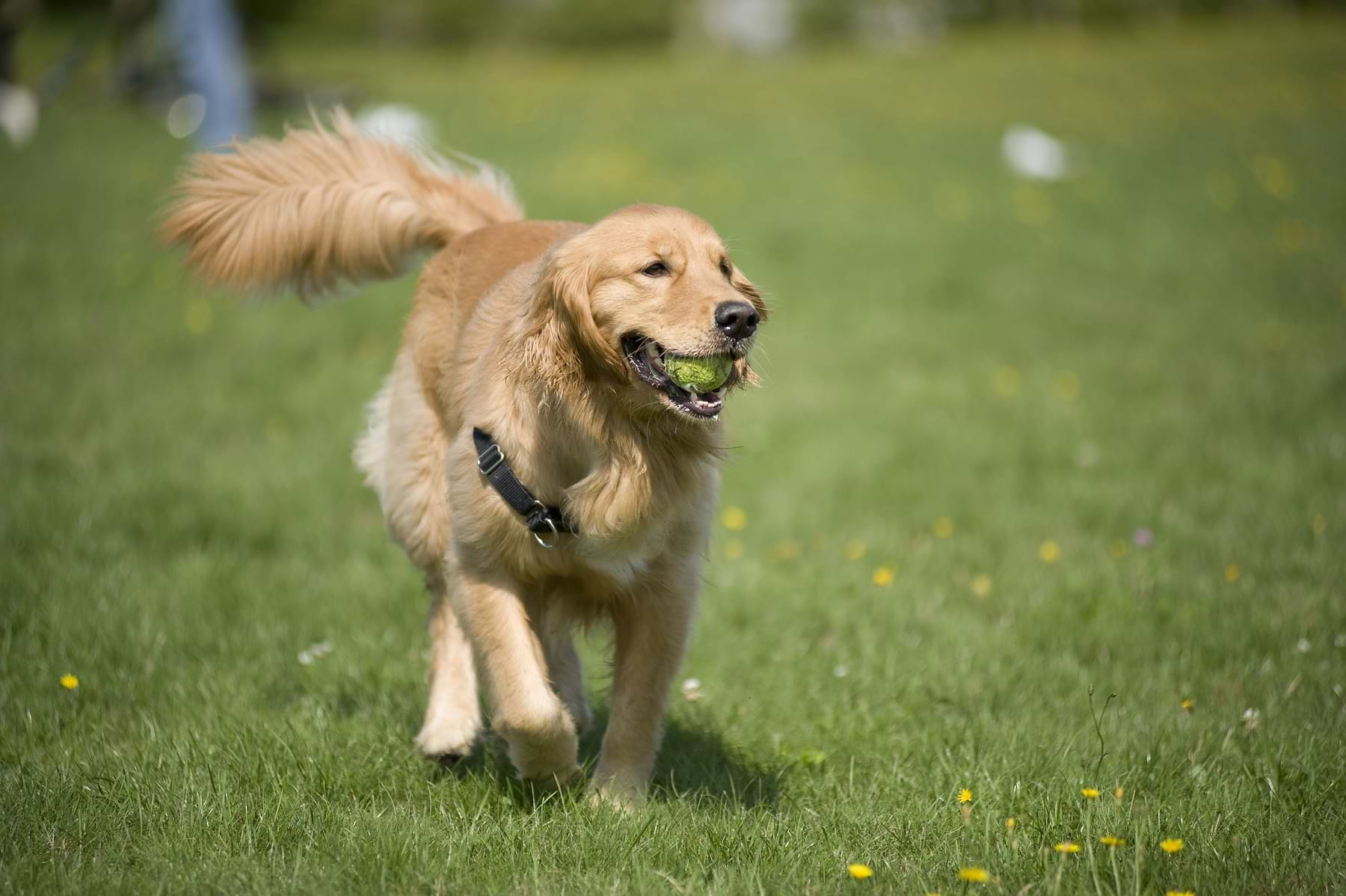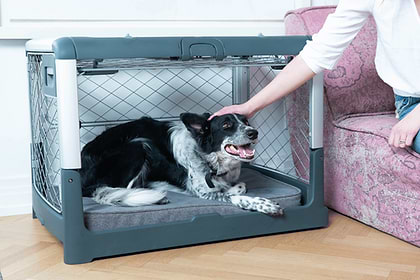What Is Dog Body Language?
Obviously, a dog’s communication is going to be very different from the way a human communicates. Dog body language is the collection of unique methods that a canine uses to communicate its emotions and intentions. It’s a compilation of sounds (barks, growls, audible yawns, etc), physical body adjustments (tail wagging, raised hackles), and even touch (jumping, licking their pet parent).
Facial expressions, like when dogs smile, are also a key component of a dog’s body language and their form of communication. Pay attention to your dog’s eyes or mouth movements like a submissive grin.
All pet parents can benefit from learning the ins and outs of canine communication. It gives humans a deeper understanding of their dog which in turn gives the canine a way better life experience.
Becoming fluent in canine body language can also help the pet parent to be a better advocate for their dog in a variety of situations like greeting other dogs, meeting new people, or even visits to the vet.
Body Posture and Movement
Pay close attention to your pup’s posture and the way they are moving their bodies. Physical adjustments and their stance can say a lot about how your dog is trying to communicate with you. So can their expressions through their eyes, ears, tails, and fur.
Eyes
There are a few ways that dogs will communicate with their eyes. Look out for the white portion of their eyeball, also known as the “sclera.” If the sclera is visible, that could mean that your canine companion is feeling tense or afraid. If this is the case, their eyes might also become rounder.
They may show a lowered head, crouching just enough to indicate passive submission.
Soft direct eye contact usually means that your pet feels safe, while a hard stare may indicate alertness, excitement, or even aggression. Whatever the emotion, it’s one of vigilance.
Dilated pupils are also a sign of alarm or fear. When a dog is scared, they are instinctually faced with fight or flight, and it’s common to see their eyes dilate. The reason for this? Dilated pupils allow more light to enter the eye, which in turn allows their brains to receive information quicker and more clearly.
Pretty neat, right? It’s important to note that pupil dilation isn’t always a bad thing. It could also signify excitement. You’ll notice dilation when you play with your dog, or when you arrive home after being gone all day.
Ears
Check out your pup’s ears. Are they up? Down? Drooping? Erect? While it’s easier to detect a change in emotion if your dog has ears that point upwards, there are things to look out for even if your canine has long, droopy ears, just like a Basset Hound!
The base of their ears will tell you a lot. When your dog is relaxed and there is no arousal taking place, the base of their ears will push back. When they are alert or startled, you’ll notice the base of their ears will move forward. If your pup’s ears are all the way pushed forward, their foreheads will usually wrinkle, which means they are on high alert.
Tail
Your dog’s tail is a great communicator. Pay close attention to both the base of the tail, as well as how the tail is moving and whether or not it is in a neutral position. A loose wag or a tail that rises above spine level usually indicates that your dog is very excited.
We see this when our dog greets us at the door, or when we take them out of their crates. We also see this when they are playing with us or other dogs. A firmer tail wag, paired with a lowered and/or tucked tail is usually the sign of a fearful dog or dog that will soon show aggressive behavior.
Fur
We’ve all seen the hair along a dog’s back rise. Compare this to a human getting goosebumps. The rising of spinal hair, known as piloerection, is synonymous with their hackles being raised. It’s not necessarily a bad thing or an indicator that your dog is upset. It usually signifies excitement, alertness, or that your dog is paying close attention to their subject, whatever it may be.
Verbal Cues
Your pet doesn’t just speak with their body. There are plenty of verbal cues that your dog will give you in an effort to communicate. Vocalization usually includes barking, growling, whining, and even audible yawns.
Barking
The pitch of your dog’s park is very telling on how your pet is feeling at that moment. Playful barks are usually higher-pitched and are accompanied by play bows. Many dogs will bark out of excitement when they are playing with other dogs, or when they are greeting you at the door.
Fear or anger barks are typically lower-pitched. They are meant to protect and can come off as a bit more territorial. Dogs may react with a growl like this if another dog is playing too rough or gets too close to their food.
Growling
There are different types of growls and they all have different meanings. Regardless, your dog is growling to tell you, or someone else, something important. Here’s a brief rundown.
Your dog might growl during play. This is an indication of fun and engagement. Nothing to fear here. This is typically a harmless growl. Dog play growls are usually higher pitched than aggressive growls. Keep this in mind as you’re deciphering your dog’s language.
Aggressive growling is usually lower-pitched and is accompanied by long and low rumbles. It can occur as an expression of power or territorial behavior, or if your pup is feeling possessive over a toy or bone. Your dog might be trying to establish their alpha position or may feel threatened. Growling from an aggressive dog should be discouraged, and can be a warning sign for an incoming bite.
Frustrated dog growling is different from the two types of growls listed above. It can occur when a dog is trying to reach their toy under the couch and cannot. It can also occur when you come home and your dog is anxiously awaiting to greet you. Frustrated growling is usually harmless and will subside relatively quickly.
Whining
It’s true that dogs whine as a way to communicate. It usually happens when a pup needs to express its needs and can vary in intensity. Whining might indicate that your dog needs a bathroom break, wants to be fed, or wants to play. Dogs also whine in pain, like if you accidentally step on their foot, or if they get stung by a bee. They might also whine in excitement after being released from their crate.
Audible Yawns
Excessive yawning could be a sign of stress in dogs. It’s proven that dogs yawn a lot when they are anxious. Maybe your dog is at an obedience training class, or they are overwhelmed by the number of pups at the park.
Have no fear though; yawning is also a sign of indifference. Go figure! If your dog is approached by another dog, and that dog is acting on the more aggressive side, your dog may yawn out of indifference or appeasement. They’re unbothered. This simply means that your dog is just not interested. And that’s that!
Responsible Pet Parenting and Talking Back
Whether they are feeling comfortable or not, there are plenty of ways to read your dog and then act appropriately. Your pet’s visual cues are a great way to better understand your companion and in turn, become closer to them. Here are some things you can do to clear the communication pathways, bond with your pet, and better hear what your dog is trying to tell you.
Crate Training
Crate training is known to make your dog feel safer and will inevitably strengthen the connection between the two of you. Crates, when used correctly, have the potential to become your pup’s safe haven. It’s a little den for your furry friend. It’s a snug home within a home. Crate training gives dogs a sense of security and safety.
Investing in a durable, well-built crate for your pup is a good place to start. It should be big enough for your pet to stand up and turn around. Incorporate a crate training aid that will assist with positive reinforcement and association, and make their space as comfortable as possible. You can do this by dressing the crate with a blanket or an orthopedic crate pad. Using treats and their favorite chews is another way to teach them that the crate is a great place to be.
Routine and Structure
Supplying your canine companion with a smooth-flowing daily routine is a great way to let your dog know that you’re listening to them. Solidify a schedule that works for both of you. Dogs typically have a positive reaction to structure. Having a daily plan will let your dog know that you hear them and that you have a deep understanding of their needs.
Paying Close Attention
Take your pet seriously and pay close attention to their body language and vocal cues. Their movements, lip-licking, and vocalization are for good reason. Take note of behavioral patterns and repetitive noises, like panting.
Track when they do certain things, where you are, and how they acclimate to certain situations. With time, you’ll be able to decipher the unique language of your furry friend that wants nothing more than to be able to talk to you.
In Conclusion
In conclusion, there are a handful of ways to learn and decipher dog body language. Firstly, understand what a dog’s body language is and how to maneuver it. Are they talking through their body movement, their posture, their eyes, paws, ears, or tail? Or are they communicating with verbal cues like barking, growling, whining, or yawning? Maybe all of the above?
After you understand what your dog is trying to say, figure out how you can communicate back. Listen and respond. Give them a daily routine. Teach them to love their crate and make them feel safe.
Lastly, pay close attention and do not disregard their efforts at communicating. This will strengthen the bond between you and your pet and give your dog the ultimate life experience.
Sources:
Understanding Dog Body Language: Decipher Dogs' Signs & Signals | American Kennel Club
7 Tips on Canine Body Language | ASPCA Pro
How to Speak Dog by Understanding Dog Body Language | Outward Hound
Why Do Dogs Bark At Each Other? | American Kennel Club
Types of Dog Growl & What Your Dog Is Trying to Tell You | Purina
Canine Communication: Deciphering What Different Dog Sounds Mean | American Kennel Club

The Diggs Team
We believe our dogs deserve safer, better designed pet products.
You might also like
Crate training tips, stories and inspiration
View all blogsIn Your Diggs
Share your photos with #DiggsPet and tag us @DiggsPet on IG and TikTok.



